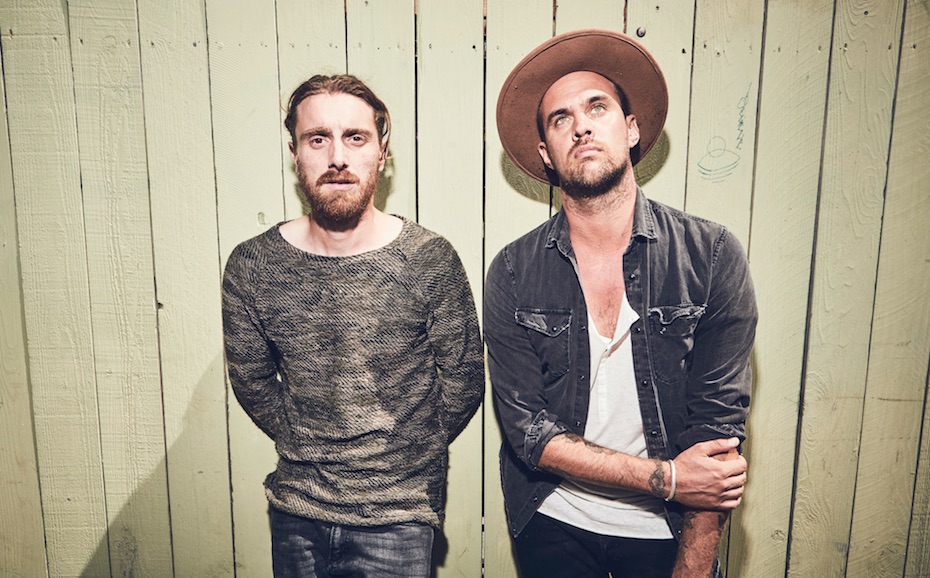
Photos by Koury Angelo
—
Previously Cardiff-based band Until The Ribbon Breaks has returned with a much-anticipated self-titled sophomore album, which is out today. Frontman Pete Lawrie-Winfield, who now resides in Los Angeles, is bravely laying bare his addiction ills, unspooled around the moody toil of his creative life and its pitfalls.
The album delivers on the imaginative production chops, stellar loops and darker shade of songwriting we’ve come to expect from UTRB since their 2015 debut A Lesson Unlearnt. It also strikes an emotive balance between the despair and self-loathing on “One Match” and the reprieve of more hopeful tracks, like “My Love,” a song Taylor Swift unexpectedly included it to her Favorite Songs Playlist in December; the simple acceptance of “Petrichor”; and the transformative, Zen-inspired “Meru.”
UTRB started out as a solo bedroom project fueled by Lawrie-Winfield’s love for film and writing alternate stories around archetypal characters such as “Romeo” or the femme fatale off David Lynch’s Lost Highway. Often he would write and make loops while the movie was projected onto the wall. As the project gained momentum he enlisted two friends to help him flesh out the songs for live shows and thereon bigger tours—opening for London Grammar and Lorde. On the new album, drummer Elliot Wall returns alongside Lawrie-Winfield and also contributes to the production.
From start to end, Until The Ribbon Breaks perfectly encapsulates the journey of how we lead our lives. We have our dreams, loves, failings and anxieties. We shuffle through taking the path of least resistance until one day we’re stopped in our tracks. If lucky the realization we need to change happens before catastrophe; either way, then begins the uphill task of recovery. As a listener, by the time you get through the 10 tracks to closer “Meru,” it’s nearly impossible to hold back tears.
Last November, we attended UTRB’s pre-album launch to experience first-hand these songs with the visuals Lawrie-Winfield meticulously edited for them. More recently, we caught up with him by phone for a heart-to-heart about his road to sobriety.
Hi Pete, we spoke at your recent album launch. You looked liked you had been through the mill; how were you feeling that night with it being the first kind of work engagement since you’d been sober?
Yeah, I mean … a lot of sobriety is almost completely about re-learning how to do everything. A huge part of substance abuse, alcoholism or anything like that, is a detachment from yourself and for however long that goes on, you get further and further away from who you are. So sobering up is a stark reality for a while; especially for me when the substance abuse and drinking was to help deal with social anxiety. For me, anything like that requires a huge intake of breath and, “OK, I am going to have to do this without a crutch.” But every time you do something like that, you realize how much easier it is sober. In the end whatever you’re abusing turns against you: Alcohol was making me more anxious rather than helping me. So they’re all huge reliefs and you get to the end of each one and it was fine, it was fun. You’re making a little notch in your brain, that actually you are really fine; so yeah, I was nervous but at the end of it, I’m not nervous about doing it again. That’s the beauty of sobriety.
And you recently did your first live show sober too, with Yes Theory.
Doing a show, that’s a whole other level. I’d never done a show sober, and never thought I could. (Pause) It was fine. I actually enjoyed it, which was a huge shock to me. It turns out playing live sober is just amazing. Just being present—you’re actually there and you can remember it!
So, first things first. What brought you to move to L.A.?
It was not a particularly nice story. I moved to America and I didn’t know a single person and for someone with those anxiety issues that probably wasn’t the best scenario. I was living in Brooklyn, and my roommate—who was my best mate—took me under his wing. He showed me New York. It crossed my mind that he had some problems with drinks and drugs, but I was busy having mine, you know. It turned out that he’d been using oxycontin and was addicted to it. In the end, he overdosed from it and it was me that found him. From the moment I found him and called the ambulance, I never went back to that apartment. I knew I had to get away.
Was it a wake-up call for you?
No, I was in huge denial, still, at that point. I often say this in AA meetings: I never drank alone. I never drank to drown my sorrows. I was a social drinker. I was drinking to make myself feel confident. And a lot of my alcoholism was a lot of fun. (Laughs) It was only at the end—and the days after. And that became every day. It just became this cycle where I would go out in the evenings and drink to alleviate social anxiety. And the next day I’d be more anxious because of the drinking. So I’d have to drink more; that just spiraled—10, 15 years of doing that. The amount you’re drinking at the end is ridiculous. But I wasn’t ready. You sober up when you hit whatever your bottom is; and everyone’s is different. The amazing thing about AA, you can be sitting next to someone who’s lost their house, family, job and they’re homeless. Or a movie executive who knew it was their time to sober up because their family told them it was time. Everyone’s degree of knowing when is different. You can be in denial long before anyone else sees there’s a problem.
On your new album, there’s no rap in recovery? Last time we talked a lot about rap. You described rap as the first time you fell in love with music, having grown up in a household of musicians. And you featured Run The Jewels and Homeboy Sandman on Lessons Unlearnt?
Because of what I went through and what the record ended up being about, this was a much more insular record. Collaboration is the last thing on your mind when you’re trying to avoid human contact. You know? (Laughs)
I noticed that “Count The Lightning” has clips from the movie Submarine. Does it take a lot to for an image, song and mood to line up? And did you need to get any copyright permission from a film’s director to use in your videos?
The first record was writing music to film, that was the birth of Until The Ribbon Breaks. That idea of the marriage of film and visuals: For example in “Romeo” the music was written directly to me projecting the film. They’re intertwined that way. The second record is much more song-based and personal, it’s about a journey. The films were made after the record. I wasn’t making video and film while I was writing the songs because I was in a little shack in Thailand. I didn’t always have the technology available. It was an interesting process, the songs were finished and I got to imagine what kind of visuals would go with it; it was a different way to getting to the same thing. “Count The Lightning” sounded to me like a really nostalgic song, it’s about childhood and Submarine is a Welsh film about growing up. In terms of copyright, I make the videos as a tribute to the films but at such time as they tell me I can’t use it, I will take it down. I’m exercising that film muscle.
In “Black and White,” the footage of the trio dancing in the dessert with a DJ booth – where’s that from? It fits so perfectly with the song. How do you come across these clips and do you know what you’re looking for when you set out to make the videos for each song?
It’s always different. That’s from a Danish film called The Legend of Kaspar Hauser. In that scenario I just happened to be watching the film. I am still such a massive film fan and watch a lot of films. I always have a notebook with film notes, time codes and what it can be used for.
One of my favorites off the new album is “My Love” – just like Taylor Swift. Where was your head at when you wrote the track?
(Laughs) For that song, I wanted to just write lyrics in terms of how they sound. I felt really limited vocally in the last record. I’ve never thought of myself as a singer. It’s kind of the last thing I want to do. I love writing lyrics but I don’t like singing. Unless I’m recording or on stage, I don’t think I’ve ever sung in my life. I am not the kind of person who sings in the shower. It’s literally just a vehicle for me to say what I want to say. So the first record I was disguising my voice because I was self-conscious about it. I used a lot of layers and effects. I was singing in a very low voice then layering it with falsettos. When it came to doing it live, it was difficult to pull it apart. On the new record, I thought, right, I’m just going to expose my voice. So I started singing in this bigger, chestier voice and I discovered I do have a singing voice. And because of that, I was discovering all these new melodies and ways to sing, just bare on top of tracks. I tend to obsessively make loops, countless loops ‘til I get bored. Then I make a new loop until that one day I feel like I can write some words and want to sing something over it. The verse melody of “My Love” was the first thing I sung over that track. I tend to just pace around the studio recording over loops and “My Love” just worked sonically. Unlike “Meru,” “One Match’ or “Petrichor,” which were more personal in subject matter, “My Love” it was just about how the words sound next to each other, I wasn’t trying to be meaningful or personal. It was fun; one of the rare songs that I just had fun making. (Laughs)
I am sure this should happen more often for you now.
You know what, I’ve seen a few comments after “Here Comes The Feeling” and “My Love” were out—I tend not to read the comments usually—but I saw on Facebook comments like “Oh no, I hope Pete didn’t get too happy.” (Laughter) These two new singles are kinda upbeat, happy, more melodic: I think some fans just wanted the old depressing “Romeo.” But I gave them what they wanted with “One Match,” so that’s fine. I think, luckily, the record has a mix of both.
The other favorite is “Petrichor.” The line, “It’s not wrong it’s moving on,” just hits you. Tell us a bit about the meaning of the word “petrichor” and how the song came about with you alone on a beach in the Far East?
I was engaged at the beginning of making the record, and I no longer am. This song addresses that...
Oh I’m sorry.
No, it’s OK. It’s all meant to be. That was the only song that addresses that and the last thing I wanted was a bitter breakup song. It’s about, “It’s not wrong, it’s moving on. All is forgiven, all is replaced.” There’s no hard feelings. You don’t always have to look back on things as what it could have been. You can just leave it as what it was, which for the majority of that, was a beautiful thing. My sister told me about the word petrichor; she said it was her favorite word. It describes that smell of rain on hot cement, and for me was a good metaphor for a new day. I kind of had the word and I wrote the song around it.
Introducing the album and interspersed throughout are quotes spoken by Jonathan Ames (who wrote an autobiographical novel called The Alcoholic and is a novelist, essayist and creator of HBO series Bored To Death ). Can you tell us how you became acquainted?
During the early stages of making this record I was still in denial. Looking back I realize I was trying to find some kind of solidarity or solace that there could be a happy ending. I started reading and listening to these audio books, addiction memoirs. I wanted versions of these stories that didn’t end badly. I was too scared to stop drinking but I knew I had to. I came across Jonathan Ames books and essays, these chapters on his life. When I make music, I lock myself away. I can spend 18 hours a day working on my music so at the end of that, when I need to unwind – the last thing I want to do is listen to music. So I started listening to his audio books. And then it became like this dream, his words and my music/ I couldn’t separate the two and I didn’t want to. So I reached out to him on Twitter—of all things—and said, “Look, you don’t know me, but I used some words from your audio books, and sampled them for my new album.” And he wrote back almost immediately and said, “I don’t know what sampling is, but by all means use it!” Then he actually came to the album launch. It’s a true taste of when it is good to meet your heroes.
You once said with regards to the looped video integral to your live shows that, “If people look at the visuals, they won’t be looking at us,” like it was some sort of escape. Where do you stand on the matter now, with your newfound sobriety on this new album?
The making of the videos and visual, painting, photography—it’s all some kind of transference of addiction in a positive way. Now that I don’t have the drinking, I don’t have that aimless searching so I make stuff. We won’t use the visuals at all, I don’t think. We don’t need something to hide behind. I’m not so worried that people can see me or hear me sing anymore. The live show should now be its own separate thing.
—
Until The Ribbon Breaks' self-titled new album is out now. Listen below.













